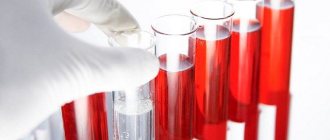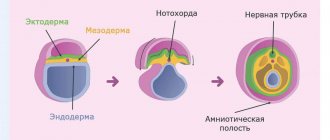Medical editor: Strokina O.A. - therapist, functional diagnostics doctor. November, 2022.
Early ventricular repolarization syndrome (EVRS) is a medical concept that includes only ECG changes without characteristic external symptoms. It is believed that SRRS is a normal variant and does not pose a threat to the patient’s life.
However, recently this syndrome has become viewed with caution. It is quite widespread and occurs in 2-8% of cases in healthy people. The older a person gets, the less likely it is that he or she will have SRR; this is due to the emergence of other cardiac problems that are similar in electrocardiographic signs as they age.
Most often, early ventricular repolarization syndrome is diagnosed in young men who are actively involved in sports, in men who lead a sedentary lifestyle, and in people with dark skin (Africans, Asians and Hispanics).
What it is
The human heart consists of 2 types of cells - typical cardiomyocytes (muscle cells that provide contraction) and atypical cardiomyocytes (generating and conducting nerve impulses).
Thanks to the activity of the latter, the heart is capable of constant and rhythmic contraction. This is called automaticity. At the moment when the heart is at rest (not contracting), positively charged particles (cations) are located outside the cardiomyocyte membrane, and negatively charged particles (anions) are located inside.
When ions begin to move through special channels, the charge of the membrane changes (inside to “+”, outside to “-”). As soon as the charge difference reaches a certain value, an excitation wave is generated (depolarization occurs), which is transmitted to the muscle cells, and the heart contracts. Then the ions return to their original place (the myocardium relaxes), and the cycle repeats again. This moment of reverse movement of ions is called repolarization.
Repolarization disorder is a very common phenomenon among both adults and children (more often in males). Moreover, it can be observed both in absolutely healthy people and in those who suffer from severe cardiac diseases.
A special type of this pathology is distinguished - early myocardial or ventricular repolarization syndrome (ERRS) , which is mainly found in adolescents and even newborns who do not have any heart disease. SRS can also be found in adults.
Description of the cardiac cycle
The contraction of the heart is caused by electrical impulses that are conducted to each cell of the myocardium (heart muscle). After receiving such an impulse, each cardiomyocyte goes through a stage of contraction and relaxation, which constitute the cardiac cycle. However, behind each of these stages there is a complex mechanism for the flow of calcium, potassium and chloride ions out of and into the cell. The electrical changes in the membranes of cardiomyocytes that underlie contraction are called depolarization, and those that underlie relaxation are called repolarization.
Click on photo to enlarge
Causes
The exact cause of disturbances in repolarization processes is unknown. Pathology can develop under the following conditions:
- Autonomic dysregulation syndrome – better known as vegetative-vascular dystonia;
- organic heart diseases - coronary disease, myocarditis, heart failure, cardiosclerosis, cardiomyopathies, thickening of the interventricular septum;
- the use of drugs that affect the excitability or metabolism of myocardial cells - antidepressants, adrenergic agonists, psychostimulants, cardiac glycosides;
- connective tissue dysplasia is a hereditary pathology characterized by insufficient production of collagen protein and manifested by joint hypermobility, increased skin extensibility, and impaired metabolic processes in the myocardium;
- changes in the blood levels of electrolytes - sodium, potassium, calcium, magnesium;
- Excessive physical activity – SIRD is common among athletes.
QT shortening
The syndrome is also very rare and may be associated with certain congenital diseases with gene mutations. Improper functioning of potassium channels leads to changes in QT duration. The shortened repolarization process is accompanied by constant arrhythmia, and the risk of sudden cardiac arrest always remains.
Short QT syndrome
Factors that allow diagnosing a shortened repolarization phase:
- Frequent attacks of arrhythmia and ventricular tachycardia, fainting.
- Sudden slowing of heart rate at any time of the day.
- ECG data. If the QT duration is less than 0.33, then this pathology will most likely be confirmed.
- Heredity. If there have been cases of sudden cardiac arrest in your family, there is a risk.
In children, the shortened repolarization process occurs in the same way as in adults. A qualified diagnostician may suspect this disease even if there are no direct symptoms.
Non-cardiac symptoms of short QT phase:
- elevated potassium or calcium levels in a blood test;
- elevated temperature;
- the initial stage of acidosis (the pH level is shifted to the acidic side);
- Digoxin use.
Possible manifestations and consequences for the body
As a rule, if repolarization is disrupted, nothing bothers a person. Therefore, in almost everyone, this syndrome is detected either during a preventive medical examination or during examination for another disease.
If symptoms appear, then only if a repolarization disorder occurs against the background of some kind of cardiac pathology. Then the patient may complain of heart pain, dizziness, rapid pulse, etc.
I am often asked whether impaired myocardial repolarization is dangerous, especially during pregnancy. No, but it may indicate the presence of cardiac disease.
As for SRRH, for a long time it was considered absolutely harmless, it was taken for an “accidental find”. However, many years of clinical studies have cast doubt on this.
It turned out that those people who had signs of SRR on the ECG have a very high risk of developing paroxysmal supraventricular tachycardia, atrial fibrillation and Wolff-Parkinson-White syndrome in the future (in a few years).
QT prolongation
The cause of this phenomenon is most often a hereditary factor; genetic changes are accompanied by improper functioning of ion channels. The case is quite rare, occurring once in 6-7 thousand people. Due to an imbalance of ions in the cells of the heart muscle, the excitation process is prolonged, which is reflected in the cardiogram.
ECG changes in various types of long QT syndrome
Such a deviation from the norm can appear at any age. The clinical picture is as follows:
- Sudden rapid heartbeat without any reason. On the ECG, this process is displayed as ventricular tachycardia with changes in the shape of the QRS complex.
- An increased QT interval may occur due to a surge of emotions (both positive and negative), or be a consequence of taking medications.
- Sudden fainting.
In a child, deviations in the repolarization process may be accompanied by the symptoms listed above, or may not appear at all. It is extremely important to establish such a disorder in time, since the syndrome can lead to sudden death.
How deviations are determined
The main and only method for diagnosing ventricular repolarization disorders is electrocardiography. The film shows nonspecific changes in the T wave (mainly in the chest leads) - it becomes high, pointed, or, conversely, its amplitude decreases, it may be negative.
Of much greater interest is the ECG diagnosis of SRGR, in which the following main signs are noted:
- ST segment elevation;
- point j, “camel hump”, “Osborne wave” – a notch on the descending part of the ST segment;
Shortening of the PQ and QT intervals may also occur.
Decoding the cardiogram requires special care from the doctor, since ST segment elevation occurs in other, more serious pathologies - angina pectoris, myocardial infarction, pericarditis, etc. Most often, the clinical picture does not help in differential diagnosis, because SRS is not accompanied by any symptoms.
However, if I find the above changes on film in an adult (especially after 40 years), then I additionally prescribe stress tests, i.e. taking an ECG while the patient is performing moderate physical activity - on a bicycle ergometer or treadmill (treadmill). With SRRH, the cardiogram returns to normal. This helps me make a differential diagnosis between the silent form of angina and heart attack.
In case of an unclear ECG picture, I use special tests with drugs. The patient is administered potassium chloride or Novocainamide. After 30 minutes, an ECG is taken. With SRR, the signs become more distinct.
To detect possible arrhythmias, I perform daily (Holter) ECG monitoring on my patients.
Since SRHR can develop against the background of organic heart disease, I prescribe echocardiography to assess the morphological structure of the myocardium.
Treatment of early ventricular repolarization syndrome
Repolarization syndrome does not require specific treatment. The only thing that is offered to the patient is observation by a cardiologist.
However, a person with SRS should avoid alcohol consumption and intense physical activity to avoid triggering an attack of tachycardia.
In some cases, radiofrequency ablation of an additional beam is performed in an invasive way (a catheter is brought to the site of the beam and destroys it).
Sometimes energotropic therapy (B vitamins, carnitine, phosphorus and magnesium preparations, Mexidol, Kudesan), antiarrhythmic drugs (amiodarone) are used.
Important! The patient should retain all previous ECGs, which is required to exclude the diagnosis of myocardial infarction if heart pain occurs.
Treatment and proper observation
There is data on the use of so-called “energotropic” drugs (Carnitine, Kudesan), which normalize metabolic processes in the myocardium. However, repolarization disorders themselves usually do not require treatment.
I prefer to pay more attention to the conditions and pathologies that caused the disorders, and if they are identified, direct therapeutic measures (medicinal and non-medicinal) to eliminate them.
In the absence of any illnesses, it is necessary to regularly see a doctor in the future. At least once a year, undergo a minimum cardiological examination - face-to-face examination, ECG, Holter monitoring.
In case of long-term course of SRR, to prevent the occurrence of arrhythmias, I use magnesium preparations, less often - antiarrhythmic drugs (Amiodarone).
If life-threatening arrhythmias occur, radiofrequency ablation may be necessary.
Kinds
There are two options for SRR:
- without damage to the cardiovascular and other systems;
- involving the cardiovascular and other systems.
From the point of view of the nature of the course, a distinction is made between transient and permanent SRGC.
Based on the localization of ECG signs, doctor A.M. Skorobogaty proposed the following classification:
- Type 1 – with a predominance of signs in leads V1-V2;
- Type 2 – with a predominance in leads V4-V6;
- Type 3 (intermediate) – without a predominance of signs in any leads.
Clinical case
I recently observed a patient who came to me with complaints of difficulty breathing, which worsened when walking, climbing stairs, and at night.
He has been suffering from arterial hypertension for several years. I did not receive any treatment. During a general examination, an increased heart rate of up to 126 per minute and high blood pressure of up to 150/95 mmHg are noted. Art., swelling of the feet and lower thirds of the legs, enlargement and tenderness of the liver upon palpation. An ECG was performed. interpretation - sinus tachycardia, diffuse disturbances in the processes of repolarization of the left ventricular myocardium, signs of left ventricular hypertrophy. The patient was referred for echocardiography. Holter monitoring revealed no other pathological abnormalities. The result is hypertrophy and dilatation (expansion) of the left chambers of the heart, a decrease in the ejection fraction of the left ventricle - 55%. A clinical diagnosis was made: “Chronic heart failure stage IIB, functional class II according to NYHA. Background disease: Stage III hypertension, stage 2 arterial hypertension.” Treatment was prescribed: limiting salt intake to 3 g per day, Bisoprolol 5 mg once a day, Perindopril 10 mg once a day, Amlodipine 5 mg once a day.
Tracking phase changes on an ECG
Diffuse changes in the repolarization process cause changes in the T wave. But it will be too early to talk about an exact diagnosis, since this is typical for any metabolic disorders, and not just in the heart muscle. If deviations of not only the T wave, but also the ST segment are observed, then there is a diffuse imbalance of cell electrolytes.
When deciphering the ECG results, the duration of the intervals between its components is measured
Prescribing treatment and making a diagnosis based on ECG results is difficult. It is necessary to collect a complete clinical picture and conduct additional studies. It is impossible to interpret the results of the electrocardiogram curve unambiguously, since the nature of the bioelectric processes is heterogeneous.
The repolarization process can be disrupted by a very serious pathology - hypersympathicotonia. This disease begins in childhood and is accompanied by increased levels of adrenaline in the blood.
Also, the reasons for deviations in the repolarization phases on the ECG curve may be due to heavy physical labor or constant stressful situations. Women during pregnancy or menopause are susceptible to the disease. A huge number of people have changes in the lower wall of the heart muscle, but are not aware of it.
Data correction
If a comprehensive examination is carried out and an accurate diagnosis is established, the specialist will prescribe treatment aimed at eliminating the causes that caused the disruption of the repolarization phases. In cases where the disease is life-threatening, surgery is prescribed - cardiac ablation.
A person who has been found to have abnormalities in the repolarization process must:
- discuss the possibility of physical activity with your doctor;
- register with a dispensary;
- do ECG regularly;
- adhere to a healthy lifestyle;
- Take medications/vitamins prescribed by your doctor.
Control the functioning of your heart by keeping it healthy!
When is treatment required?
The question of the need to treat disorders of repolarization processes should be resolved as soon as possible after they are detected on the cardiogram and further examination of the patient. In the absence of a causative cardiac pathology, the patient is prescribed medications or a pacemaker is installed, based on the presence or absence of clinical manifestations of tachyarrhythmias (fainting, tachycardia, heart failure).
Thus, due to the fact that short QT interval syndrome often leads to life-threatening ventricular tachyarrhythmias, all patients with this syndrome need to determine the indications for implantation of an electrical pacemaker (pacemaker) (cardioverter-defibrillator).
Patients with long QT syndrome require pacemaker implantation if they have a history of life-threatening arrhythmias or a high risk of sudden cardiac death (for example, there is a family history of sudden cardiac death at a young age for no apparent reason and without the presence of obvious cardiac pathology). If the risk is not great, it is enough for the patient to take a drug from the group of beta-blockers (BAB), for example, Concor, Egilok, Coronal, etc.
In case of early repolarization syndrome without other cardiac pathology (isolated ERR, for example, in athletes), it is enough for the patient to limit participation in sports events and competitions. If there is organic damage to the myocardium, a complex of necessary drugs is prescribed (nitrates for ischemic changes and angina pectoris, diuretics for heart failure, antihypertensives for hypertension, etc.).
Thus, short QT syndrome requires treatment in any case , and early repolarization syndrome and long QT syndrome require treatment when there are clinical manifestations of tachyarrhythmias in the form of fainting and/or a high risk of sudden cardiac death has been identified and/or there is any other heart pathology. But in any case, the treatment is completely selected by the attending physician, since self-medication can cause irreparable harm to health.










